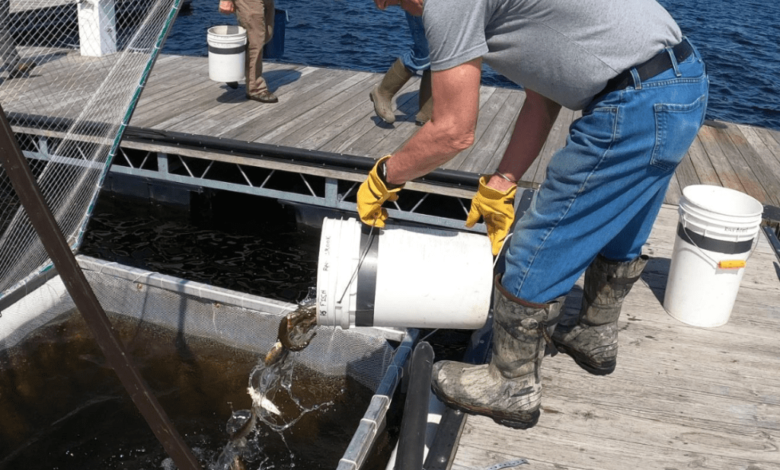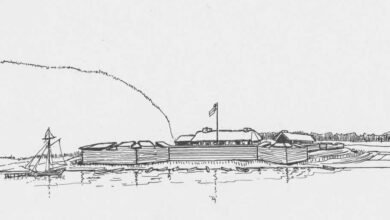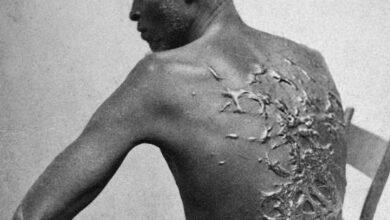Project Rearing Atlantic Salmon for the Saranac River Enters Final Year


 A five-year project experimenting with raising Atlantic Salmon in Lake Champlain on the Saranac River estuary is entering it final year. The project team is studying how to increase returns of the popular fish to the Saranac River to spawn each year on their own.
A five-year project experimenting with raising Atlantic Salmon in Lake Champlain on the Saranac River estuary is entering it final year. The project team is studying how to increase returns of the popular fish to the Saranac River to spawn each year on their own.
Six experimental net pens are being deployed at the Plattsburgh Boat Basin and Oasis Marina docks from April 4 to May 1. Atlantic salmon smolts will be stocked into the net pens to improve survival and imprinting to the Saranac River.
A smolt is the juvenile stage of the salmon life cycle where it begins a period of significant physiological changes to adapt. Salmon are known for their ability to return to their river of origin (homing) to spawn. The window for imprinting is a few weeks during the pre-smolt to smolt transition.
Although the same species as the sea-run Atlantic salmon, landlock salmon remain in freshwater their entire lives. Young salmon look very much like their close relative the brown trout until they reach about six inches in length. At this time, the salmon turn silver and move downstream into Lake Champlain. It can take up to three years for young salmon to grow large enough to move into the lake.
Once in the lake, smelt soon become the salmon’s main food. Growth is rapid and a year later some salmon are 18 inches long. Unlike coho, chinook and other Pacific salmon which spawn once before completing their life cycle and dying, mature landlocked and sea-run Atlantic salmon may survive several spawning runs.
On the New York side of Lake Champlain, there are two runs of landlocked salmon in the Boquet, Saranac and Ausable rivers each year – in the spring and fall. During spring, salmon are attracted to the rivers by the warmer water temperatures and/or the increased stream flow resulting from spring run-off. The salmon remain in the rivers from mid-April to late May.
The main salmon run occurs in the fall when the salmon are returning to their home rivers to spawn, usually from early September into mid-November.
This Saranac River project will compare two lots of approximately 26,000 salmon smolts to continue evaluating the effectiveness of net pen rearing as a stocking method. A comparison between the stocking methods using returning adults will determine if pen rearing results in greater survival and homing than conventional (direct) stocking.
Pen rearing capitalizes on this life strategy, holding pre-smolt salmon in pens near the Saranac River for three weeks before they move into the lake. After two to three years of growing in the lake, the salmon will return to their home river to spawn in the fall.
Any salmon fry produced in the Saranac River will spend up to three years living and growing in the river (imprinting) and are expected to return to the Saranac River, continuing the life cycle.
Part of the experimental pen-rearing project is using Parental Based Tagging (genetics) to determine a fish’s origin and ultimately the contribution of pen-stocked fish to the river fishery.
Any fry captured in annual surveys will have a sample taken and it can be determined whether it was produced by a stocked fish or by a wild fish. If the fry is from a stocked fish, then it will be known which stocking treatment they were from.
The Plattsburgh Boat Basin and Oasis Marinas is providing the docks again this year. Sebago strain landlocked Atlantic salmon smolts are being provided by the Dwight D. Eisenhower National Fish Hatchery.
The state’s Adirondack Fish Hatchery transports the smolts from Eisenhower to the net pens and to the river for direct stocking. DEC Region 5 Fisheries supplies the net pens and coordinates a volunteer program with the Lake Champlain Chapter of Trout Unlimited. Volunteers feed the salmon daily and monitor them until they are released.
The project is a partnership between with the New York State Department of Environmental Conservation (DEC), the U.S. Fish and Wildlife Service, the Lake Champlain Chapter of Trout Unlimited and State University of New York (SUNY) Plattsburgh.
Funding for the project is provided through the Sport Fish Restoration Program, which provides funds to fish and wildlife agencies of the states, the District of Columbia, and U.S. territories for fishery projects, boating access, and aquatic education.
The program was created in 1950, with the passing of the Sport Fish Restoration Act (the Dingell-Johnson Act) during the administration of Democratic President Harry S. Truman. Modeled after the successful 1937 Wildlife Restoration Act (the Pittman-Robertson Act, signed by FDR), the Sport Fish Restoration Act dedicated permanent funding for fishery conservation.
Read the 2024 pen-rearing report here. Watch a video about the pen-rearing project here.
Source link




